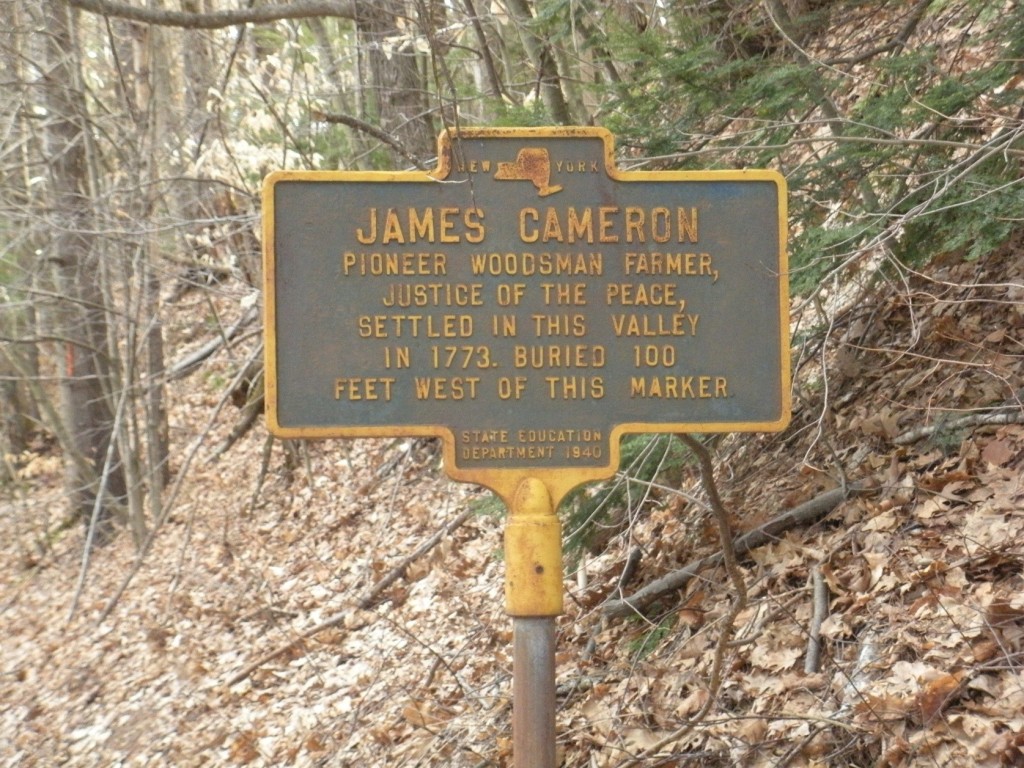DFH Volume 1 Issue 22

My visit to the land of the Dayton homestead and the gravesite of Henry Dayton [Henry← Charles Erastus← Wilber Sr.] and his wife, Christie [Cameron] Dayton made me realize that I have not mentioned our Cameron branch of the Dayton family in an earlier Newsletter. The Camerons [our ancestors] are prominent citizens in the Hadley, Stony Creek and Thurman area of Upstate New York. The Cameron surname is the most often found name in the town of Thurman, Warren County, New York, which the Camerons settled 200 years ago. Our link to this illustrious family is through the marriage of Christie Ann Cameron to Henry Dayton about 1816.
The name Cameron comes from the Gaelic and Welsh “Cam” meaning crooked and “sron” meaning nose – therefore, a crooked nose.
Christie’s parents were William (born in Scotland in 1770) and Mary Hodgson (born in England in 1776). In all, there were eight children, and Christie Ann was the oldest. Christie’s grandfather was James CAMERON and her grandmother was Christina Ann MORD. Christie Dayton was no doubt named after her grandmother. The grandparents also came from Scotland at the same time as Christie Ann’s father. There were thirteen children in this family and William was 2nd oldest. It’s not clear why James Cameron chose Thurman to live. They were from the Scottish Highlands and this may be why they chose the Adirondacks.
The author of THE CAMERON FAMILY OF WARREN COUNTY, NEW YORK, Gloria Bailey Jackson, provides a possible explanation for the Cameron’s emigration from Scotland. James emigrated about 1770 and settled in Thurman in 1773. At the time, Thurman was a part of Queensbury located in Washington County. The aftereffects of the Battle of Culloden on 16 April 1746 included the British determination to clear the Scottish Highlands of the clan system. The Cameron’s probably lived in Lochaber under the protection of their chief Donald of Locheil. Following the Battle, the Duke of Cumberland declared that the “people must perish by sword and famine.” The Cameron’s fled after they experienced plundering and burning of homes in their own clan.
Once settled in America, James began lumbering the wilderness. (Chip and Paul resumed the lumbering business 6 generations later).
In his will, William wrote, “to my eldest daughter Christian Dayton, one cow within one year after my decrease.” Joel Dayton, brother of Henry, was a witness to the will, dated 1 April 1816.
The following article is copied from an internet article titled “James Cameron – Pioneer woodsman farmer, written and published by the Warren County Bicentennial Celebration, URL http://warrenny200.org/towns/thurman/cameron.php
Among the earliest residents were Scottish immigrants, among whom were the Camerons. They came in 1773, bearing a letter of introduction from John Thurman. They settled on a large tract of land along the river often referred to now as “the Gillingham farm,” working the relatively rich bottomland and using cascading streams to power mills for sawing wood and grinding grain. James Cameron, often referred to as “Squire Jimmy,” was a Tory.
A state historical marker on the west side of Warrensburg-Stony Creek Road near the present boundary between Thurman and Stony Creek attests to his importance to the town : “James Cameron – Pioneer woodsman farmer, justice of the peace. Settled in this valley in 1773. Buried 100 feet west of this marker.” Family records indicate that he was 103 years old. The Cameron family still thrives in Thurman; a sawmill first built in the 1860s by Almyron Cameron and his son Henry remains in the family, though the blades are now stilled. Henry’s son Don ran the mill, and in 1938 the structure was destroyed by fire. The mill was rebuilt, with a new water wheel. In 1946 Don turned the mill over to his sons Myron and Don, who again replaced the wheel, but also added the option of diesel power to the existing water power. Don died in 1988, and Myron continued to operate the mill for some years.
Almyron Cameron lived in a log cabin on the flats below the mill, and after the cabin burned, he built a plank house, which he and his sons gradually enlarged. In the 1830s it became a destination for guests, a tradition they continued until the 1930s. Before one wing was removed, it boasted 16 guestrooms. Guests flocked there to enjoy hunting, fishing, hiking, mountain climbing, swimming, playing shuffleboard and croquet, and standing around the Tonk piano singing songs. Vegetables, milk butter and eggs were raised on the farm to serve the guests. Generations of the family ran the facility. When the Farmhouse was unable to accommodate all who wished to visit, the Camerons built what was known as the “Lodge”, a long structure with ten more bedrooms that was built on the hill behind the house.